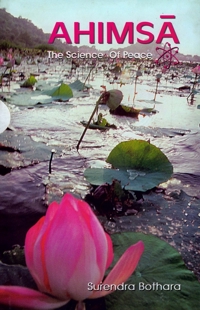AUTHOR’S NOTE
The first edition of this book was received well and appreciated for its approach. International scene has undergone considerable transformation since then but the usefulness of ahimsa as a potent instrument of universal peace remains unchanged. The only unfortunate part is that its application has not enhanced as much as it ought to be.
We give more emphasis to hasty short-term solutions and grossly neglect long-term solutions. We tend to forget that to fight disease one has to strengthen the body besides giving curative treatment. In the same way steps to strengthen the moral, ethical, humanitarian and economic fabric of the society have to be given due importance and priority.
After further elaboration on ahimsa way of life, specially with reference to prevailing problems of terrorism and environmental degradation, I have included some suggestions regarding its wider application. Religious organizations including the Jain can be of great help in this direction. However, leaving aside some welcome exceptions, they are reluctant to compromise their self-imposed ritualistic rigidity.
The perpetrators of rigid codes conveniently forget that Mahavir gave the unique principle of relativity of truth. When he called something right he did not mean that it was right for everyone at all times, at all places and under all conditions. It means that there is a scope of a thing being right for someone under certain circumstances but the same thing may be wrong for some other person or even the same person under different parameters of time, place and circumstances.
For a thing to be claimed right its parameters have to be defined.
In a dynamic system the governing rules or the truth too has to be dynamic. When we try to make it static or absolute, we trigger disintegration, regression and himsa. In order to pursue the path of peace one should devise methodology based on needs of times with a judicious mixture of theory, practice and ritual. I hope my little contribution in this direction will be of some use.
I am thankful to Dr. Atul K. Shah and Young Jains, London for being considerate enough to give permission to reproduce a portion of his booklet ‘Experiments with Jainism’ (A workbook on Jainism in practice). Special thanks to my friend Prof. L. A. Babb of Amherst College, USA for his encouragement, valuable suggestions and help in giving final shape to the new chapter. Last but not the least my thanks to Shri D.R. Mehta for prodding me to finish this long overdue task.
Jaipur,
24th April 2004
Surendra Bothara
AUTHOR’S NOTE
(from first edition)
It was mere coincidence that nudged me to start working on this book. During a general discussion about some forthcoming publications of Prakrit Bharti, Shri D.R. Mehta expressed his concern about the dearth of books on Jainism directed at the modern citizen. His observation was quite correct; most of the books available are either blindly traditional or too scholastic in style to appeal to modern man. He wondered if I could do such a book, or a series, especially on the Jain codes of conduct for the citizen. I couldn’t but say yes, and here is the outcome of my first attempt.
I started with the idea of dealing with the Anuvrats (minor vows) in modern context. The research gradually made me shift towards Ahimsa, which is the most important of the five vows of Jains, and without which all the other vows lose their value. The Jain thinkers have developed the concept of Ahimsa in a unique and comprehensive way. Mahavir and his followers elaborated Ahimsa in such detail that it became universally applicable.
Ahimsa should not be considered just a part of Jainism or Buddhism or for that matter any particular religion. Its importance lies in accepting it as a universal concept, around which almost every religion has developed a variety of ideas, in many directions and useful to humanity in many ways. It is so fundamental that it is part of nature itself.
It is my earnest request to my readers that they try to understand, ponder over, and apply the philosophy of Ahimsa to their own individual life as a component of their own particular society. Do not treat this work just as another book. Consider it as one component of a dialogue. The second component has to come from the reader in form of views, questions and experiences. Please send your part of the dialogue to us. It might form into a chain of thoughts and may be useful to everyone as a means to understand more and more about Ahimsa. Come, let’s again make it dynamic, which is its true nature.
My sincere thanks to Shri D.R. Mehta for inspiring me to take up this work as well as for his continued follow up. My father, Shri Shubh Karan Singh, has guided and helped me in my research besides providing an atmosphere conducive to philosophical thinking and bold enquiry since my childhood. It is certainly not adequate, but still I would like to record my gratitude to him.
Thanks are also due to Miss Rose DeNeve for copy reading and valuable suggestions. Nikhil Bhandari deserves a very special mention for the attractive cover design he has made, taking out time from his busy schedule at art school. Last but not least, thanks to Dr. Shamsher Bhandari for providing volumes on nature sciences and other subjects from his personal collection.
I am indebted to the scholars and publishers, of past and present, from whose books I have drawn information, references and quotes.
Jaipur
30th Nov. 1987
Surendra Bothara
 Surendra Bothra
Surendra Bothra

